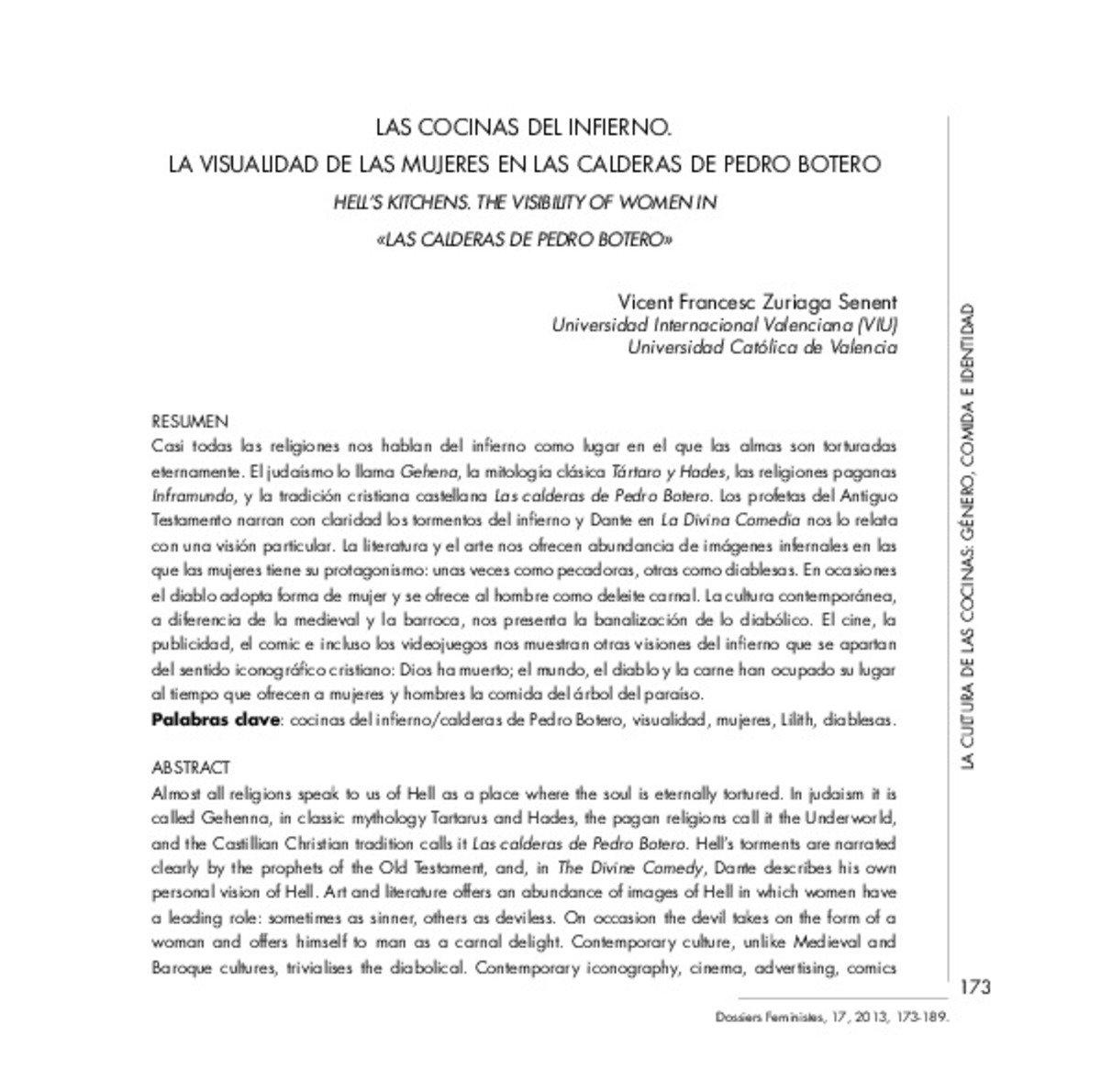Mostrar el registro sencillo del ítem
LAS COCINAS DEL INFIERNO. LA VISUALIDAD DE LAS MUJERES EN LAS CALDERAS DE PEDRO BOTERO
| dc.contributor.author | Zuriaga Senent, Vicent Francesc | |
| dc.date.accessioned | 2015-11-18T11:18:22Z | |
| dc.date.available | 2015-11-18T11:18:22Z | |
| dc.date.issued | 2013 | |
| dc.identifier.issn | 1139-1219 | |
| dc.identifier.issn | 2340-4930 | |
| dc.identifier.uri | http://hdl.handle.net/10234/140671 | |
| dc.description.abstract | Casi todas las religiones nos hablan del infierno como lugar en el que las almas son torturadas eternamente. El judaísmo lo llama Gehena, la mitología clásica Tártaro y Hades, las religiones paganas Inframundo, y la tradición cristiana castellana Las calderas de Pedro Botero. Los profetas del Antiguo Testamento narran con claridad los tormentos del infierno y Dante en La Divina Comedia nos lo relata con una visión particular. La literatura y el arte nos ofrecen abundancia de imágenes infernales en las que las mujeres tiene su protagonismo: unas veces como pecadoras, otras como diablesas. En ocasiones el diablo adopta forma de mujer y se ofrece al hombre como deleite carnal. La cultura contemporánea, a diferencia de la medieval y la barroca, nos presenta la banalización de lo diabólico. El cine, la publicidad, el comic e incluso los videojuegos nos muestran otras visiones del infierno que se apartan del sentido iconográfico cristiano: Dios ha muerto; el mundo, el diablo y la carne han ocupado su lugar al tiempo que ofrecen a mujeres y hombres la comida del árbol del paraíso. | ca_CA |
| dc.description.abstract | Almost all religions speak to us of Hell as a place where the soul is eternally tortured. In judaism it is called Gehenna, in classic mythology Tartarus and Hades, the pagan religions call it the Underworld, and the Castillian Christian tradition calls it Las calderas de Pedro Botero. Hell’s torments are narrated clearly by the prophets of the Old Testament, and, in The Divine Comedy, Dante describes his own personal vision of Hell. Art and literature offers an abundance of images of Hell in which women have a leading role: sometimes as sinner, others as deviless. On occasion the devil takes on the form of a woman and offers himself to man as a carnal delight. Contemporary culture, unlike Medieval and Baroque cultures, trivialises the diabolical. Contemporary iconography, cinema, advertising, comics and even videogames show us other images of Hell which move away from the Christian iconographic meaning: God is dead, the world, the devil and the flesh have taken his place while at the same time offering women and men fruit from the Tree of Knowledge | ca_CA |
| dc.format.mimetype | application/pdf | ca_CA |
| dc.language.iso | spa | ca_CA |
| dc.publisher | Universitat Jaume I. Institut Universitari d'Estudis Feministes i de Gènere | ca_CA |
| dc.relation.isPartOf | Dossiers Feministes, núm. 17 | ca_CA |
| dc.rights.uri | http://rightsstatements.org/vocab/CNE/1.0/ | * |
| dc.subject | cocinas del infierno/calderas de Pedro Botero | ca_CA |
| dc.subject | visualidad | ca_CA |
| dc.subject | mujeres | ca_CA |
| dc.subject | Lilith | ca_CA |
| dc.subject | diablesas | ca_CA |
| dc.subject | Hell’s kitchens/calderas de Pedro Botero | ca_CA |
| dc.subject | visibility | ca_CA |
| dc.subject | women | ca_CA |
| dc.subject | Lilith | ca_CA |
| dc.subject | vampires | ca_CA |
| dc.subject.other | Dones -- Revistes | ca_CA |
| dc.subject.other | Feminisme -- Revistes | ca_CA |
| dc.title | LAS COCINAS DEL INFIERNO. LA VISUALIDAD DE LAS MUJERES EN LAS CALDERAS DE PEDRO BOTERO | ca_CA |
| dc.title.alternative | HELL’S KITCHENS. THE VISIBILITY OF WOMEN IN «LAS CALDERAS DE PEDRO BOTERO» | ca_CA |
| dc.type | info:eu-repo/semantics/article | ca_CA |
| dc.rights.accessRights | info:eu-repo/semantics/openAccess | ca_CA |
| dc.relation.publisherVersion | http://www.e-revistes.uji.es/index.php/dossiers/article/view/1217/1091 | ca_CA |







